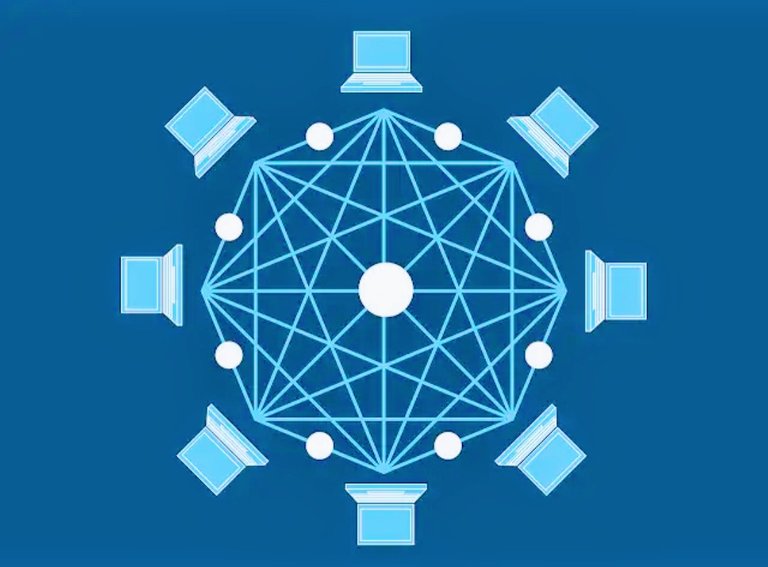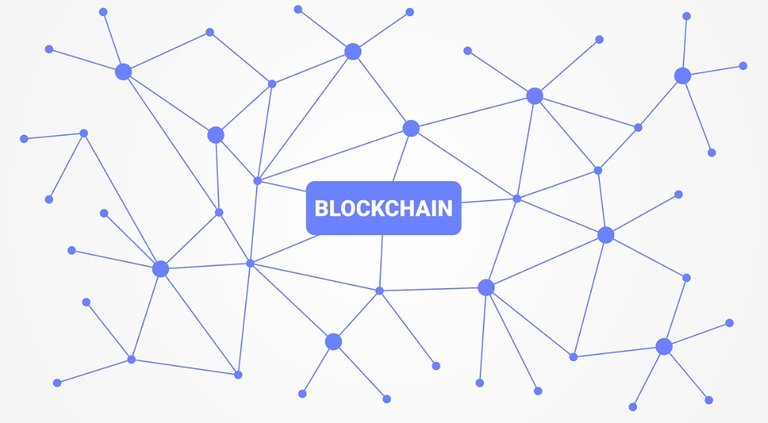Web 3: Decentralization and the future of internet.

Blockchain technology computer symbol network connection web Source Author:MaiconFZ
The internet have grown with other information technologies and is arguably the most popular information technology. With the infinite connection of people from different locations and background surfing the internet everyday via the web, the internet presents a platform for information dissemination at a flash speed, relative to pre-existing means. Together with these pre-existing and emerging information technologies, the internet has made information spread at an amazing speed.
Functioning as an application layer protocol running on the internet, the web has become a home to many ideas and many innovations, it has form a huge part of the internet age, to many; the internet age is championed by the web, this is not any far from the fact however as computer programming languages have enabled the creation of utilities on the web. It is hence not only a protocol on the internet, it has become quite home to everyone who has access to the internet, well crafted gadgets have also been developed to enable more enhanced and efficient web functionalites.
‘The World Wide Web' takes you to a world of infinite possibilities and opportunities.
During its first generation, the web was mainly a hub of information and ‘documents’, simply a platform hosting information written in hypertext markup language (HTML), with little or no user interaction with the website. Emergence of more advanced programming languages including the HTML and also the evolution of the computer and the internet enabled the creation of web platform with more user interactivity, a web platform were users can interact with the website to a very large and also with other users visiting the website, thus the birth of Web 2.0
Coined by Darcy Dinucci in 1991 to imply a second generation in the web evolution; the term ‘web 2.0' is a collaborative and participative web platform which allows it users to perform social activities on the web such as generating their own content and interacting with content generated by by other users of the platform and also with the users who generated this content, hence the concept of social web / social media. Several web 2.0 applications have had a major influence on our everyday life, from blogging platforms to video hosting and sharing platforms where user can interact with contents, generate and share their own contents. With the web 2.0 resources, commercial applications have been built on the Wed and information from a web 2.0 platform can be distributed to and used by other platforms via information distribution algorithms such as web APIs and RSS (RDF Site Summary)
Web 2.0 platforms are hosted on a server with one web server controlling activities on the platform, this control is unlimited and spans across almost every aspect of the platform such as content generation and information distribution on the platform, personal profile creation and personal profile details. Owners of these platforms hence posses total control of the platform. This serves some positive purposes as owners of the platform can easily control activities on the platform to ensure that it complies with the terms and conditions specifications, this ability to censor contents generated of web 2.0 platforms leaves its users with the role of ‘mere participants' who hold almost zero control over how they are treated on the platform.
On the dark side, owners of web 2.0 have at my instances mis-used their access to every activities on their platforms including confidential information about the users the platform, information about topics of interest have also been censored of put down by the controllers of these platforms in cases where such information is against their interests or gives put vital information on some issues which exposes certain parties related to the platform. Having known the enormous influence information has on the audience, parties directly concerned in a subject and other interested parties tend to modify information reaching out to the audience as regards the subject, putting away some aspects of the information going out, modify it to suit their interests; and in most cases Suppressing others who have access to more knowledge about the subject from sharing this information. If there’s any specie in the information age that has been endangered by the web 2.0, it is the freedom of speech
While centralized internet have arguably created a healthy internet, it’s dark side is big enough to override this imagined regulations, for instance, Cryptocurrency speakers and enthusiasts are currently having a rough time with video hosting platforms as well as blogging platforms as articles and videos related to cryptocurrency are being censored, put down and in some cases, their profiles on these platforms are banned or restricted as the case may be. This simply attacks a topic of interest which people needs to have the right information about, while topics like this do not pose any threat to human life or negatively disrupts existing information, many harmful activities and contents are left to float these platforms.
Failure of the web 2.0 in these aspects have once again left the internet users scrambling for a healthier environment where they hold some of not total authority over how their generated contents and personal information are handled by the administrators of the platform; a decentralized platform where users are in charge of themselves and others have almost no direct control over their activities.
In a decentralized internet, each user is like a well fenced building in an estate and each building fenced individually with another common fence protecting the whole estate. This depicts an independent platform where the users are independent of the administrators and other users as each profile is hosted differently on the platform. On contrast to centralized platforms, decentralized web platforms presents a disseminated governance system where each member have tangible control of their activities. Decentralized web platforms are also known as WEB 3.0 platforms.
The web 3.0 redefines the back-end of the web, distributing equal rights to each user while the web front end remains relatively the same with the front end working as usual, however the back-end is structured to serve equal rights to users. The web 3.0 revolution is led/enabled by the blockchain technology. The blockchain is a ‘chain of blocks’, Blocks are permanent stores of uneditable data/information , these includes information such as agreements between the parties in the transactions, the name of the sender, name of the recipient and the amount transacted, a block could store just any information, in cryptocurrency transactions which is the most popular context of blockchain application, a block holds records of all recent transaction, however, for a new information to be stored, a new block must be created which has a reference to the previous block as information cannot be added to the previous blocks and it’s information cannot be edited, to store a new information, a new block must be created. Each block contains a record of data and a identical hash (a cryptographic code) which identities the block. To ensure more security and stability of the blockchain, the blockchain servers (node) are run by each user of the blockchain, every user running a node verifies each block before it is created.

Web 3 platforms are powered by the blockchain technology Source Author:Tumisu
Web platforms built on the blockchain copies this concept too. Each user who creates an account on the platform owns an account which runs on the blockchain. Activities by each user are verified by other users and is stored on the block. The block is immutable, hence these activities including contents generated by the user and the user profiles are stored permanently on the blockchain and cannot be censored of removed completely from the blockchain. This solves the problem created by the centralization of the web in web 2.0.
The future is decentralized, any challenges?
Web 2.0 platforms continues to wallow in centralization and censorship by administrator of these platforms as complaints from content creators on these platforms continues to rise, emerging web 3 platforms on the other hand have delighted its users with its immutability and decentralization, content creators on these platforms are rest assured of the safety of the contents they generate as well as the safety of their accounts which they have worked so hard to build. This been said, most web 3 platforms also offers a flexible means of remuneration –cryptocurrency.
Cryptocurrencies are cryptographic tokens which runs on a blockchain, they are a flexible store of value and in some blockchains, they enable to users to access certain features of the blockchain, these tokens can be easily transferred from one user to another. In contrast to certain web 2.0 platforms, this flexible means of remuneration relieves the users of the huge stress they go through to monetize the contents they create on web 3.0 platforms. Giving the ability to monetize every form of participation on web 3 platforms, web 3 platforms have also created more interactivity on the web as every user is incentivized to participate in form of creating contents or interacting with contents created by other users.
Web 3 platforms offers immutability and censorship resistance, one would wonder how it regulates unhealthy activities on the platform. Popular web 3 platforms such as Steem blockchain and Hive blockchain exhibits a regulatory feature known as Downvoting, every user on the platform has the ability to downvote contents which doesn’t seem right or doesn’t comply with their norms. Downvoting a content reduces its approval ratings and in some cases, the remuneration of the content creator, reduction of the approval ratings of these contents also reduced its visibility too many downvotes on a content hides the content from public view, these contents as a matter of fact still remains on the blockchain and can still be accessed, it’s contents still remains intact, however it’s visibility have been hurt…badly.
Remuneration scheme in existing web 3 platforms creates a dilemma; shifting the power of remuneration to the people and creating inequality in the remuneration influence has paved way for some unhealthy activities on web 3 platforms. Platforms such as Steem and Hive determines individual influence on remuneration of contents by the steem power and hive power held by the individual on these respective platforms. This divide greatly affects the acceptability of web 3 platforms as many good contents goes under-rewarded and even unrewarded in some cases while contents inferior to them are highly rewarded due to support from high influence users. This creates an unhealthy divide in web 3 platforms in contrast to web 2 platforms where every user holds equal remuneration ability. High influence users also holds the ability to censor contents generated on the platform as downvotes from greatly affects the visibility of contents on the platform, even though they are unable to remove contents from the platform, they are able to hide it from the general view, an act which is equivalent to censorship in web 2.
Coupled with the remuneration issues and shifting of control to powerful users on the platforms, Web 3 platforms creates another form of centralization with a different censorship concept. The power as a matter of fact doesn’t really rest equally on the users, but on the high power/influence users. This defeats the centralization goal as the safety of contents created on the platforms and remuneration of the creators lie not on the quality of the content but on the ability to impress the high power users. For these reasons, many still prefers the centralized web to the decentralized web.
If the future will be decentralized and web 3 platforms must get the win, then these issues must first be tackled, the blockchain shifts power to the community, however a healthy community only exists where the users are equal in influence and rights, by shifting in equality leads to centralization as seen in popular web 3 platforms.
What are the other challenges facing decentralized web platforms? Share your thoughts in the comments
#posh
https://twitter.com/agboifesinachi/status/1254983583871176706?s=19